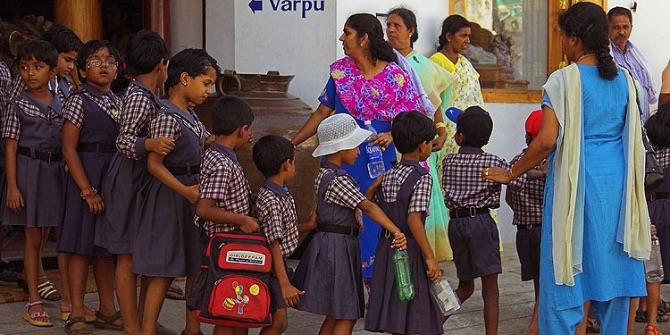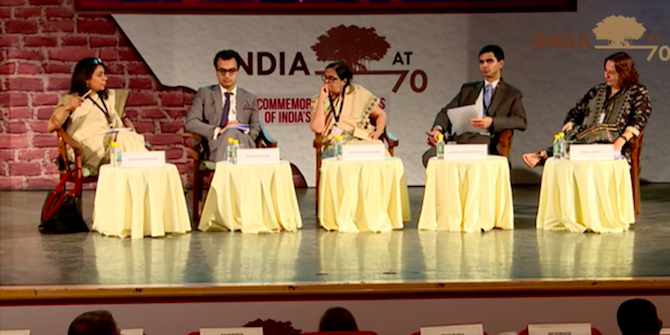LSE’s C.J. Fuller and Haripriya Narasimhan describe how the marriage system of the Eighteen-Village Vattimas has changed with the end of child marriage and the growing value of individuals’ education, employment, and compatibility. This article is the final instalment of a three-part series on changing marriage norms among middle-class Indians.
Since the nineteenth century, Brahmans in Tamilnadu, south India, have migrated from villages to towns and cities and entered new fields of modern, professional employment. By the end of the twentieth century, a traditional elite of Brahman landlords had become a predominantly urban, middle-class group. The Vattimas, numbering around 30,000, are the smallest Tamil Brahman subcaste and are further subdivided into the ‘Eighteen-Village Vattimas’ and several smaller units that today mostly belong to India’s urban middle class. In recent decades, the Vattimas’ marriage system has changed markedly: among the Vattimas – in common with other Tamil Brahmans and other Indians – a form of arranged, endogamous companionate marriage has developed, which reflects and expresses their status as a middle-class subcaste.
Eighteen-Village Vattimas generally recognise that the close ties seen as distinctive of their small community are linked to endogamy (marrying within a specific group), though marriage outside the subcaste is increasingly common as old traditions are abandoned. The most significant change has been the end of child marriage and the rising marriage age for both males and females. Despite the Child Marriage Restraint Act, which became law in 1929 and fixed the minimum age for marriage at 14 for girls and 18 for boys (since 1978, the respective ages have been 18 and 21), child marriage continued among the Eighteen-Village Vattimas—the last known occasion was in 1973. Since then, however, child marriage has ended. Vattimas do not cite specific reasons for abandoning child marriage, although several people mentioned the growing importance of girls’ education and conservatives described child marriage as an anachronism inconsistent with the modern, middle-class way of life.
Moreover, most Vattimas no longer prefer close-kin marriage. The Eighteen-Village Vattimas – in common with most south Indians – formerly had a preference for marriages between cross-cousins or between uncle and niece. But the majority now prefer marriages between partners who are unrelated or only distantly related. This change is owing to concerns about ‘inbreeding’ (specifically, fear that the offspring of closely related parents may suffer congenital diseases or disabilities) as well as other factors. Younger women argue that an unrelated mother-in-law is preferable because a wife is then under less pressure from her own family to tolerate any abuse. Another reason is that close-kin marriage often reinforced alliances between landowning families and prevented property from devolving outside them, but this no longer matters to the many urban Vattimas who have sold their land.
The first exogamous marriage probably occurred in the early 1980s. Now, most Eighteen-Village Vattimas are prepared to accept other Tamil Brahmans, but normally only if a suitable partner from their own subcaste cannot be found. Thus the Vattimas provide a clear, if unusual, example of how subcaste endogamy can remain the dominant norm, in both preference and practice, even for a group with so many members living in cities or overseas.
Although arranged, endogamous marriage still remains the norm, both ideally and statistically, the mode of arrangement has changed because of the increasing importance of the educational qualifications and employment of individual men and women. People assume that any sensible conversation about marriage must also be about education and employment. The prestige rankings for Vattimas are standard ones: degrees from elite colleges are highly esteemed and IT professionals and business consultants are probably thought to have the best jobs. For women, who now marry in their early twenties, the prestige rankings are almost the same: educated, professional husbands prefer wives who are also educated—though not to a higher standard than themselves.
Interestingly, middle-class marriage has progressively developed in recent years into a companionate form. Vattimas, like other Tamil Brahmans and many other Indians, now regard the future couple’s happiness as vitally important. The concern with future happiness is the primary motive for increasingly consulting young men and women before arranging a marriage and encouraging them to communicate with each other before a marriage is finalised.
Despite the greater involvement of young people in arranging their own marriages, for the majority of middle-class Indians, arranged endogamous marriage remains the norm. In most groups, inter-subcaste unions have become more acceptable and common, although in some of them – including the Eighteen-Village Vattimas – a strong preference for subcaste endogamy persists, notwithstanding the development of a companionate form of marriage. In sum, (sub)caste endogamy is functionally consistent with companionate marriage and is not a survival from an earlier epoch before an Indian middle class and its new forms of marriage arrangement emerged. Companionate marriage as it now exists also plays a fundamental role in the emergence and reproduction of the middle class.
For more information on this topic, see C.J. Fuller and Haripriya Narasimhan, “Companionate marriage in India: The changing marriage system in a middle-class Brahman subcaste”, Journal of the Royal Anthropological Institute Volume 14, Issue 4, December 2008.
Click here to read an interview with Dr Henrike Donner on the middle-class ideal of an Indian marriage, the first instalment of the series.
Click here for an article that analyses why a strong preference for intra-caste marriages endures despite changing economic incentives, the second instalment of the series.








